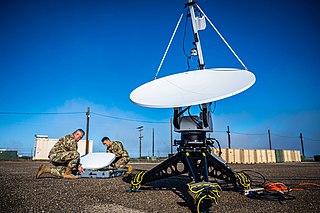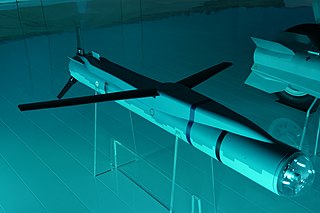
The Defense Advanced Research Projects Agency (DARPA) is a research and development agency of the United States Department of Defense responsible for the development of emerging technologies for use by the military.

Electromagnetic warfare or electronic warfare (EW) is warfare involving the use of the electromagnetic spectrum or directed energy to control the spectrum, attack an enemy, or impede enemy operations. The purpose of electromagnetic warfare is to deny the opponent the advantage of—and ensure friendly unimpeded access to—the EM spectrum. Electromagnetic warfare can be applied from air, sea, land, or space by crewed and uncrewed systems, and can target communication, radar, or other military and civilian assets.

The United States Naval Research Laboratory (NRL) is the corporate research laboratory for the United States Navy and the United States Marine Corps. It was founded in 1923 and conducts basic scientific research, applied research, technological development and prototyping. The laboratory's specialties include plasma physics, space physics, materials science, and tactical electronic warfare. NRL is one of the first US government scientific R&D laboratories, having opened in 1923 at the instigation of Thomas Edison, and is currently under the Office of Naval Research.

The Naval Undersea Warfare Center (NUWC) is the United States Navy's full-spectrum research, development, test and evaluation, engineering and fleet support center for submarines, autonomous underwater systems, and offensive and defensive weapons systems associated with undersea warfare. It is one of the corporate laboratories of the Naval Sea Systems Command. NUWC is headquartered in Newport, Rhode Island and has two major subordinate activities: Division Newport and Division Keyport in Keyport, Washington. NUWC also controls the Fox Island facility and Gould Island. It employs more than 4,400 civilian and military personnel, with budgets over $1 billion.
Roke Manor Research Limited is a British company based at Roke Manor near Romsey, Hampshire, which conducts research and development in the fields of communications, networks, electronic sensors, artificial intelligence, machine learning, data science, Military decision support consultancy and operational analysis, information assurance, and human science. In addition to supporting its parent Chemring, Roke undertakes contract research and development, and product development work for both public and private sector customers. Products developed from research at Roke Manor include the Hawk-Eye ball tracker, which is now used widely in sports such as tennis, football, and cricket.

The Office of Naval Research (ONR) is an organization within the United States Department of the Navy responsible for the science and technology programs of the U.S. Navy and Marine Corps. Established by Congress in 1946, its mission is to plan, foster, and encourage scientific research to maintain future naval power and preserve national security. It carries this out through funding and collaboration with schools, universities, government laboratories, nonprofit organizations, and for-profit organizations, and overseeing the Naval Research Laboratory, the corporate research laboratory for the Navy and Marine Corps. NRL conducts a broad program of scientific research, technology and advanced development.
The U.S. Navy Electronics Laboratory (NEL) was created in 1945, with consolidation of the naval radio station, radar operators training school, and radio security activity of the Navy Radio and Sound Lab (NRSL) and its wartime partner, the University of California Division of War Research. NEL’s charter was “to effectuate the solution of any problem in the field of electronics, in connection with the design, procurement, testing, installation and maintenance of electronic equipment for the U.S. Navy.” Its radio communications and sonar work was augmented with basic research in the propagation of electromagnetic energy in the atmosphere and of sound in the ocean.

The 453d Electronic Warfare Squadron is a United States Air Force unit. It is assigned to the 850th Spectrum Warfare Group and is stationed at Lackland Air Force Base, Texas.
SIMDIS is a software toolset developed by Code 5770 at the US Naval Research Laboratory (NRL). The software provides 2D and 3D interactive graphical and video displays of live and postprocessed simulation, test, and operational data. SIMDIS is a portmanteau of simulation and display.

Naval Surface Warfare Center Crane Division is the principal tenant command located at Naval Support Activity Crane. NSA Crane is a United States Navy installation located approximately 25 miles (40 km) southwest of Bloomington, Indiana, and predominantly located in Martin County, but small parts also extend into Greene and Lawrence counties. It was originally established in 1941 under the Bureau of Ordnance as the Naval Ammunition Depot for the production, testing, and storage of ordnance under the first supplemental Defense Appropriation Act. The base is named after William M. Crane. The base is the third largest naval installation in the world by geographic area and employs approximately 3,300 people. The closest community is the small town of Crane, which lies adjacent to the northwest corner of the facility.
A wireless ad hoc network (WANET) or mobile ad hoc network (MANET) is a decentralized type of wireless network. The network is ad hoc because it does not rely on a pre-existing infrastructure, such as routers or wireless access points. Instead, each node participates in routing by forwarding data for other nodes. The determination of which nodes forward data is made dynamically on the basis of network connectivity and the routing algorithm in use.

Command and control is a "set of organizational and technical attributes and processes ... [that] employs human, physical, and information resources to solve problems and accomplish missions" to achieve the goals of an organization or enterprise, according to a 2015 definition by military scientists Marius Vassiliou, David S. Alberts, and Jonathan R. Agre. The term often refers to a military system.
Defence Electronics Research Laboratory (DLRL) is a laboratory of the Defence Research & Development Organization (DRDO). Located in Hyderabad, it is actively involved in the design and development of integrated Electronic Warfare systems for the Indian Armed Forces.
The Combat Aircraft Systems Development & Integration Centre (CASDIC) is a laboratory of the Indian Defence Research and Development Organisation (DRDO). Located in Bangalore, Karnataka, India, It is one of the two DRDO laboratories involved in the research and development of airborne electronic warfare and mission avionics systems.

The Operational Test and Evaluation Force (OPTEVFOR) is an independent and objective agency within the United States Navy for the operational testing and evaluation (OT&E) of naval aviation, surface warfare, submarine warfare, C4I, cryptologic, and space systems in support Navy and Department of Defense acquisition programs.
AWR Corporation is an electronic design automation (EDA) software company, formerly known as Applied Wave Research, and then acquired by National Instruments
Walter Rotman was an American scientist known for his work in radar and antenna design. Among his inventions were the Rotman lens, the sandwich wire antenna, and the trough waveguide.

The Select Precision Effects At Range (SPEAR) Capability 3, or simply referred to as SPEAR 3 is a future British air-to-ground and possibly anti-ship cruise missile that could also be considered a loitering munition. It is currently planned to be integrated on the Eurofighter Typhoon, F-35B Lightning and possibly Tempest.
The Internet of Military Things (IoMT) is a class of Internet of things for combat operations and warfare. It is a complex network of interconnected entities, or "things", in the military domain that continually communicate with each other to coordinate, learn, and interact with the physical environment to accomplish a broad range of activities in a more efficient and informed manner. The concept of IoMT is largely driven by the idea that future military battles will be dominated by machine intelligence and cyber warfare and will likely take place in urban environments. By creating a miniature ecosystem of smart technology capable of distilling sensory information and autonomously governing multiple tasks at once, the IoMT is conceptually designed to offload much of the physical and mental burden that warfighters encounter in a combat setting.
The Atmospheric Sciences Laboratory (ASL) was a research institution under the U.S. Army Materiel Command that specialized in artillery meteorology, electro-optical climatology, atmospheric optics data, and atmospheric characterization from 1965 to 1992. ASL was one of the seven Army laboratories that merged to form the U.S. Army Research Laboratory (ARL) in 1992.










